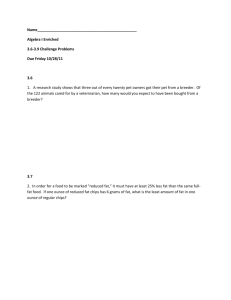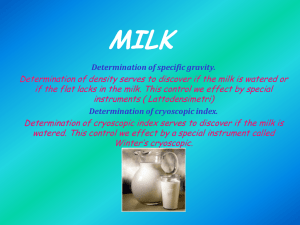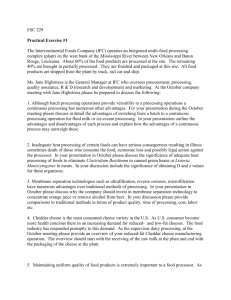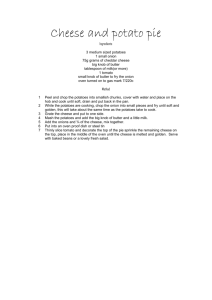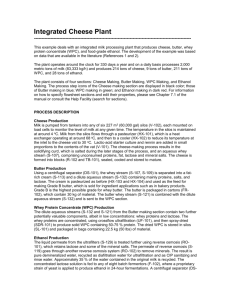A review of federal milk marketing order reform
advertisement
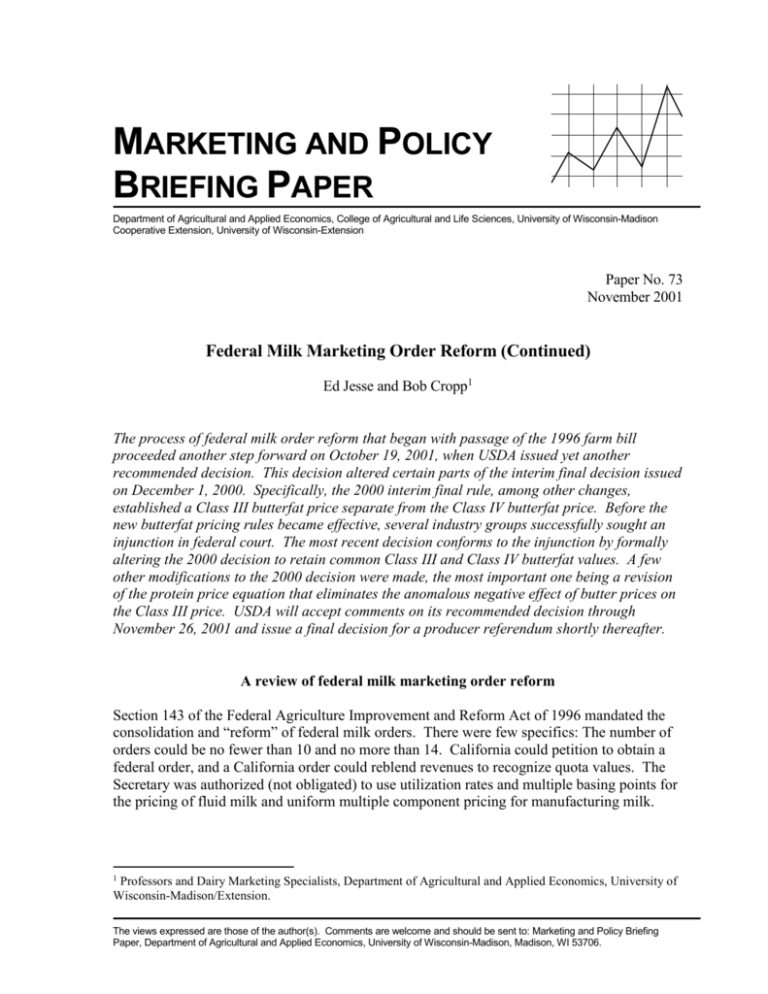
MARKETING AND POLICY BRIEFING PAPER Department of Agricultural and Applied Economics, College of Agricultural and Life Sciences, University of Wisconsin-Madison Cooperative Extension, University of Wisconsin-Extension Paper No. 73 November 2001 Federal Milk Marketing Order Reform (Continued) Ed Jesse and Bob Cropp1 The process of federal milk order reform that began with passage of the 1996 farm bill proceeded another step forward on October 19, 2001, when USDA issued yet another recommended decision. This decision altered certain parts of the interim final decision issued on December 1, 2000. Specifically, the 2000 interim final rule, among other changes, established a Class III butterfat price separate from the Class IV butterfat price. Before the new butterfat pricing rules became effective, several industry groups successfully sought an injunction in federal court. The most recent decision conforms to the injunction by formally altering the 2000 decision to retain common Class III and Class IV butterfat values. A few other modifications to the 2000 decision were made, the most important one being a revision of the protein price equation that eliminates the anomalous negative effect of butter prices on the Class III price. USDA will accept comments on its recommended decision through November 26, 2001 and issue a final decision for a producer referendum shortly thereafter. A review of federal milk marketing order reform Section 143 of the Federal Agriculture Improvement and Reform Act of 1996 mandated the consolidation and “reform” of federal milk orders. There were few specifics: The number of orders could be no fewer than 10 and no more than 14. California could petition to obtain a federal order, and a California order could reblend revenues to recognize quota values. The Secretary was authorized (not obligated) to use utilization rates and multiple basing points for the pricing of fluid milk and uniform multiple component pricing for manufacturing milk. 1 Professors and Dairy Marketing Specialists, Department of Agricultural and Applied Economics, University of Wisconsin-Madison/Extension. The views expressed are those of the author(s). Comments are welcome and should be sent to: Marketing and Policy Briefing Paper, Department of Agricultural and Applied Economics, University of Wisconsin-Madison, Madison, WI 53706. USDA was required to complete a “progress report” on consolidation and reform by April 1, 1997, issue proposed amendments no later than January 1998 and issue final rules no later than January 1999 with implementation by April 1999. Funding for the order program would be terminated if these deadlines were not met except in the event of court injunctions that delayed implementation. USDA took its task seriously, conducting several internal analyses and commissioning even more outside studies. The principal issues addressed were order consolidation, pricing of manufacturing classes and component pricing, uniform classification, and the structure of Class I differentials. The last issue proved to be the most contentious. USDA issued a proposed rule by the January 1998 deadline and a final rule in March 1999. The final rule adopted modified “Option 1B” Class I differentials, which were substantially “flattened” from existing differentials. In particular, the rule reduced Class I differentials in the Northeast by $0.63 per hundredweight. Following a producer referendum in which all of the new orders were approved, a Federal District court in Vermont issued an injunction against implementing the amendments. Later in 1999, Congress passed legislation as part of an omnibus spending bill to require adoption of “Option 1A” differentials, which were slightly higher than existing differentials in most markets and retained the existing geographical Class I price surface in markets east of the Rocky Mountains. The same legislation also mandated USDA to reconsider the Class III and Class IV formulas included in the amendments and implement any new formulas by January 1, 2001. The modified amended orders became effective on January 1, 2000. The principal changes were:2 Consolidation of orders from 31 to 11. Replacement of the Basic Formula Price with a system of product price formulas that relate milk component values to product prices and assumed yields and make allowances. Adoption of the higher of advanced Class III or Class IV skim milk values as the price mover for Class I skim milk. In response to the Congressional mandate to reconsider Class III and Class IV formulas, USDA conducted a hearing in May 2000. A major portion of the hearing was devoted to the formulas generating Class III prices. A particular problem was the Class III protein price formula, which attempted to adjust for the difference in the value of butterfat used in cheese versus butter. This resulted in a negative relationship between butter prices and the Class III price – a 10-cent per pound increase in the price of butter reduced the Class III price by 4 cents per hundredweight. This anomaly was exacerbated by high butter prices relative to 2 For more information on the nature and effects of order reform to date, see Order Reform and Reforming Order Reform, Marketing and Policy Briefing Paper No. 71, December 2000. The paper can be obtained from the University of Wisconsin website, Understanding Dairy Markets at http://www.aae.wisc.edu/future. M&P #73 Page 2 of 8 cheese prices in 2000, forcing down the Class III price relative to the Class IV price and causing the advanced Class IV skim value to consistently serve as the Class I mover. The Class III price was severely depressed in 2000, but the relatively high Class IV price resulted in a major increase in the Class I – Class III price difference. In December 2000, USDA issued a tentative final rule based on the hearing and subsequent briefs. Some product yield assumptions and make allowances were modified in the amendments. But the biggest changes related to the adoption of a new Class III butterfat price derived from a formula linked to the value of butterfat in cheese. The protein formula was also altered to value protein in cheese independent of butterfat in cheese. A pooling mechanism was defined to accommodate separate butterfat prices for Class III and IV in determining producer butterfat value. And the “higher of” Class I mover provision was modified to use the higher of Class IIII or Class IV prices at 3.5 percent butterfat rather than skim milk prices. Whichever Class price was highest would, in turn, dictate the applicable Class I skim milk and butterfat prices. Defining separate butterfat classes solved the problem of the Class III price being negatively related to butter prices. But it created many new potential problems. Diverse producer and processor groups from every region coalesced to repudiate the change in a harmonious manner that has seldom, if ever, been observed in the dairy industry. Even though the final rule was approved by a producer referendum and published in the Federal Register on December 28, the separate Class III-Class IV butterfat provision never went into effect. The January 2001 advanced prices were announced on December 22, 2000. Perhaps fortunately, the advanced Class IV price exceeded the advanced Class III price, so Class I skim and butterfat values for January 2001 were determined in the same manner as before the December final rule. Before the monthly January prices could be announced on February 2, a federal District court enjoined USDA from using separate butterfat classes. USDA was required to revert to a single butterfat price for Class III and Class IV. The Newest Reforms The October 19, 2002 recommended decision addresses the injunction and makes a few other changes from the December 2000 final rule. First, the other changes: The make allowance in the Class III Other Solids formula was increased from $0.14 to $0.159. “Old” formula: Other Solids Price = (NASS Dry Whey Price – 0.14)/0.968 “New” formula: Other Solids Price = (NASS Dry Whey Price – 0.159)/0.968 This change was in response to witnesses who argued that the manufacturing allowance for dry whey should be higher than for nonfat dry milk because byproduct values are less. The impact of this change is an other solids price that will be about 2 M&P #73 Page 3 of 8 cents per pound lower. This equates to approximately 12 cents per hundredweight of milk. The lower bound of zero on the Class III other solids price was eliminated. Previously, the other solids price was “snubbed” at zero – if the other solids formula yielded a price less than zero, the value, zero, was used in calculating the Class III price and producer other solids value. USDA was apparently persuaded by cheese industry witnesses’ comments that low whey values impact negatively on plants bottom line, and should be reflected in component values. A negative other solids price would occur at a dry whey price of less than 15.9 cents per pound (the whey make allowance). Based on the recent trading range for dry whey, the probability of this occurring is slim. The NASS weekly whey price has exceeded 15.9 cents per pound every week since it first reported in September 1998. Move three high-fat products (frozen cream, plastic cream, and anhydrous milk fat) back from Class IV to Class III. These products were reclassified with the separation of Class III and Class IV butterfat. Since there is no separation in the new rules, there is no longer a need to reclassify. Eliminate butterfat pooling. This is another “conforming change” that undoes a previous change necessitated by the separate butterfat classes. The primary change in the October 19 proposed rule is in the Class III protein formula. The formula that has been used since January 2001 is: Old Protein Price/Lb. = (NASS Cheese Price – 0.165) * 1.405 + (((NASS Cheese Price – 0.165) * 1.582) – BF Price) * 1.28 The first expression represents the value of protein in cheese. The second expression represents the value of butterfat in cheese net of the value of butterfat in butter. The proposed modification is to the net value of butterfat in cheese: New Protein Price/Lb. = (NASS Cheese Price – 0.165) * 1.405 + (((NASS Cheese Price – 0.165) * 1.582) – 0.9*BF Price) * 1.17 The change may appear trivial – the butterfat price is adjusted by .9 and the multiplier is reduced by 0.11. However, the effects are substantial. M&P #73 Page 4 of 8 First, USDA finally did address the problem of butter prices negatively affecting the Class III price. This can be demonstrated mathematically. The Class III price is defined as 0.965 times the Class III skim milk price plus 3.5 times the butterfat price. The Class III skim milk price is defined as 3.1 times the protein price plus 5.9 times the other solids price. The other solids price is related exclusively to the dry whey price. So in the old protein formula, the Class III price changed with the butterfat price as follows: -0.965*3.1*1.28*(Butterfat price) + 3.5*(Butterfat price) = -0.329*(Butterfat price). Dividing through by the .82 butterfat yield factor, this is equivalent to a four-cent per hundredweight decrease for a 10 cents per pound increase in butter prices. With the new protein formula, the Class III price change is: -0.965*3.1*1.17*0.9*(Butterfat price) + 3.5*(Butterfat price) = +0.350*(Butterfat price). This indicates the Class III price would increase by 4.3 cents with a 10 cents per pound increase in the butter price. Second, and more important, the revision in the protein price formula increases the protein price for any given level of cheese prices. Comparing the protein price calculated using the new formula with the reported protein price between January 2000 and September 2001, the new formula yields a 19.15-cent per pound higher price. The equivalent increase in the Class III price is about 57 cents per hundredweight. Combined with the lower other solids price, the net effect on the Class III price from the proposed rule is 45 cents per hundredweight. In other words, had the new formulas been in effect since January 2000, Class III prices would have averaged 45 cents per hundredweight higher. As suggested by the figure below, the Class IIII price increases attributable to the new protein formula are largest when butter prices are high. When butter prices were above $1.60 per pound, the new formula generated Class III prices more than 60 cents per hundredweight higher than actual Class III prices The new protein price formula makes it somewhat less likely that the Class IV price will consistently serve as the mover of Class I prices, particularly given the butter-powder “tilt” implemented by USDA in April 2001. The chart below shows actual advanced Class III and Class IV prices since inception of the “higher of” mover of Class I in January 2000. Also shown are the advanced Class III price using the new formulas for protein and other solids and the advanced Class IV price at $.90 per pound, the current CCC purchase price for nonfat dry milk. Note that with the new protein formula, Class III would have been the mover in only one additional month (July 2001). However, with nonfat dry milk at its new support level, Class III would have been the mover in five additional months. M&P #73 Page 5 of 8 Monthly Class III Prices 18.00 1.80 New Formulas Difference (Right Scale) 14.00 Class III Prices,$/Cwt 1.60 Actual 1.40 12.00 1.20 10.00 1.00 8.00 0.80 6.00 0.60 4.00 Average Difference (Jan '00 through Sep '01) is 45 cents per hundredweight 2.00 0.00 Jan '00 0.40 Monthly price difference, $/Cwt. 16.00 0.20 0.00 Apr Jul Oct Jan '01 Apr Jul Oct Advanced Skim Prices $11.00 New Formulas - Class II Actual Class III $10.00 Actual Class IV Class IV with NDM @ $.90 $9.00 $.Cwt. $8.00 $7.00 $6.00 $5.00 $4.00 M&P #73 Ju l Au g Se p O ct N ov D ec Ju l Au g Se p O ct N ov D e Ja c n '0 1 Fe b M ar Ap r M ay Ju n ar Ap r M ay Ju n M Ja n '0 0 Fe b $3.00 Page 6 of 8 Since nonfat dry milk and whey prices are comparatively stable, whether Class III or Class IV serves as the Class I mover depends mainly on the relative prices of Grade AA butter and Cheddar cheese as reported by NASS. The chart below demonstrates this relationship with nonfat dry milk prices fixed at $0.95 per pound and dry whey prices fixed at $0.25 per pound (both prices at current levels). The chart can be interpreted as follows: With the assumed NDM and dry whey prices, the combination of butter and cheese prices will determine whether the advanced Class III or Class IV price is the Class I mover. For example, at a NASS two-week cheese price of $1.50, the NASS two-week Grade AA butter price would have to exceed $1.80 per pound for Class IV to be the Class I mover. With butter at $1.20, the cheese price would have to be higher than about $1.27 for Class III to be the mover. The equation embodied within the chart more specifically identifies the critical cheese price (cheese price above which Class III will be the Class I mover) as related to butter, nonfat dry milk, and whey prices: C = 0.0908 + 0.3944B + (9* NDM – 6.095*W)/10.0934 Where C is the advanced NASS cheddar cheese price, B is the butter price, NDM is the nonfat dry milk price, and W is the dry whey price. M&P #73 Page 7 of 8 This equation indicates that with dry whey at 25 cents per pound and other commodities at CCC support levels (cheese: $1.1314, butter: $.8548, and nonfat dry milk: $0.90), Class III will be the Class I mover. That is, the CCC purchase price for cheese is higher than the calculated critical cheese price of $1.08 per pound. Summary Comments The newest proposed rule represents an evolving improvement over the initial federal order reforms implemented on January 1, 2000, the subsequent amendments implemented a year later, and the pricing rules that became effective after the January 2001 injunction. USDA found a much better way than using separate butterfat prices to prevent high butter prices from lowering Class III milk values. And the procedure that USDA adopted has the added benefit of raising Class III skim values. In our judgment, the proposed protein price formula more appropriately values the value of protein and butterfat in cheese and provides better signals to producers. The revision in the Class III pricing formula along with the unrelated reduction in the CCC purchase price for nonfat dry milk increases the likelihood that Class III will move Class I. However, the recent trading ranges for butter and cheddar cheese strongly suggest that Class IV will usually serve as the Class I mover, even if nonfat dry milk price reach support. This suggestion is confirmed by futures prices through September 2002, which show Class IV contracts trading at $0.60-$1.20 per hundredweight above Class III. “Higher of” pricing does not make good economic sense. It has become abundantly clear from nearly two years of experience that the dairy price support program will continue to floor Class I prices through the CCC purchase price for nonfat dry milk. And the Class III skim price continues to be strongly negatively affected by the butter price. This raises the specter of maintaining Class IV as the mover by keeping butter prices high enough to offset the positive effect of rising cheese prices on Class III skim values. Expanding cheese use means an increasing proportion of the U.S. milk supply moving through cheese plants. It is unreasonable to decouple fluid milk prices from competitive market forces driving the largest segment of the dairy industry. USDA refused to notice a proposal to use a weighted average of Class III and Class IV prices as a Class I mover. The proposal notes that, “The hearing record supports the continued relationships between the Class IV and Class II prices and between the higher of the manufacturing class prices and the Class I price.” It is difficult for us to understand what in the hearing record supports using Class IV to consistently move Class I. In 2000, Class IV utilization represented less than 8 percent of total federal order deliveries; Class III use was 43 percent. In 2000, the CCC purchased 693 million pounds of nonfat dry milk, 48 percent of total production. CCC purchases of cheese in 2000 were 28 million pounds, 0.3 percent of total cheese production. M&P #73 Page 8 of 8
